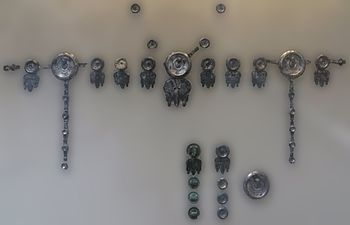Xanten Horse-Phalerae
| Xanten Horse-Phalerae | |
|---|---|
 Horse-Trappings from Xanten as displayed in the British Museum | |
| Material | Silvered bronze |
| Size | Diameter of largest phalera - 10.5 cm |
| Created | 1st Century AD |
| Present location | British Museum, London |
| Registration | GR 1854.7-17.53 (Bronzes 2871) |
The Xanten Horse-Phalerae is the name of a set of Roman silvered bronze horse-trappings found in Xanten, Germany. The set is now in the British Museum's Greek and Roman antiquities collection.
One of the decorations bears an inscription meaning "while Pliny was prefect of cavalry". This provides an important link to the famous Roman historian Pliny the Elder, who later witnessed the destruction of Pompeii.
History
The horse trappings were found in the early nineteenth century at the Roman city of Castra Vetera near modern-day Xanten in the state of North Rhine-Westphalia. Castra Vera was an important Roman army camp for the Classis Germanica regiment that provided protection and security along the frontier of the Roman Empire. The heightened military presence encouraged the development of a large city nearby that became the second largest settlement in the province of Germania Inferior.
Inscription to Pliny the Elder
Gaius Plinius Secundus, better known as
Description
The set of horse-trappings is made of about 60 silvered-bronze
See also
Gallery
-
Image of a roundel with the bust of an emperor
-
Detail of the phalera with Latin inscription
Bibliography
- L. Burn, The British Museum Book of Greek and Roman Art (British Museum Press, 1991)
- S. Walker, Roman Art (British Museum Press, 1991)
- I.D. Jenkins, 'A group of silvered-bronze horse-trappings from Xanten (Castra Vetera)', Britannia-2, 16 (1985), pp. 141–64


